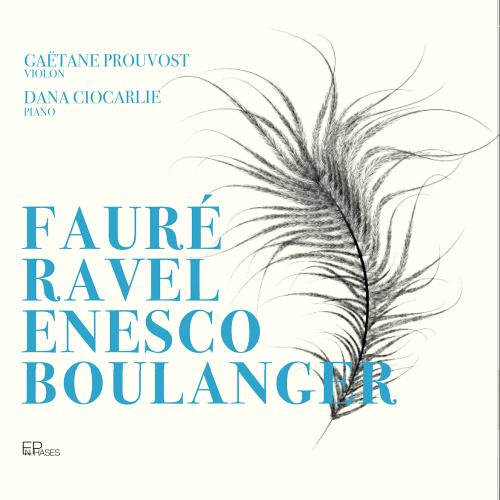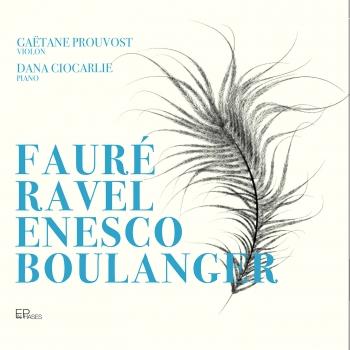
Fauré, Ravel, Enesco & Boulanger Gaëtane Prouvost & Dana Ciocarlie
Album info
Album-Release:
2023
HRA-Release:
20.10.2023
Label: EnPhases
Genre: Classical
Subgenre: Instrumental
Artist: Gaëtane Prouvost & Dana Ciocarlie
Composer: Lili Boulanger (1893-1918), George Enescu (1881-1955), Maurice Ravel (1875-1937), Gabriel Faure (1845-1924)
Album including Album cover
- Lili Boulanger (1893 - 1918): 2 Pieces for Violin and Piano:
- 1 Boulanger: 2 Pieces for Violin and Piano: No. 1, Nocturne 02:54
- 2 Boulanger: 2 Pieces for Violin and Piano: No. 2, Cortège 01:40
- Georges Enesco (1881 - 1955): Pièces pour violon et quatre mains:
- 3 Enesco: Pièces pour violon et quatre mains: I. Pastorale 03:36
- 4 Enesco: Pièces pour violon et quatre mains: II. Menuet triste 04:11
- 5 Enesco: Pièces pour violon et quatre mains: III. Nocturne 04:55
- Maurice Ravel (1875 - 1937): Violin Sonata No. 1, M. 12:
- 6 Ravel: Violin Sonata No. 1, M. 12 13:36
- Pavane pour une infante défunte, M. 19:
- 7 Ravel: Pavane pour une infante défunte, M. 19 (Arr. for Violin and Piano by Paul Kochanski) 05:20
- Berceuse sur le nom de Fauré, M. 74:
- 8 Ravel: Berceuse sur le nom de Fauré, M. 74 02:52
- Gabriel Fauré (1845 - 1924): Violin Sonata No. 2, Op. 108:
- 9 Fauré: Violin Sonata No. 2, Op. 108: I. Allegro non troppo 09:42
- 10 Fauré: Violin Sonata No. 2, Op. 108: II. Andante 07:56
- 11 Fauré: Violin Sonata No. 2, Op. 108: III. Allegro non troppo 06:25
Info for Fauré, Ravel, Enesco & Boulanger
We know Gabriel Fauré the composer well but little the pedagogue. This recording aims to highlight the influence of the composer in France and even in Europe when, in 1896, he became professor at the Paris conservatory taking over from Massenet. The program of this disc wishes to bring together one of the work of his last périod and compositions by his illustrious students: Ravel, Boulanger et Enesco.
In 1896, Jules Massenet resigned from his composition class at the Conservatoire to devote himself to his work on opera and was replaced by Gabriel Fauré. At the age of 52, Fauré was then ‘Inspector of musical education’, a tiring but modest post from a social standpoint. His applications to l’Institut de France and to the post of music critic for the Figaro had foundered, and although he had gained an honorable recognition in the music world, his career had stalled somewhat. He kept on his com-position class for nine years before being appointed Director of the Conservatoire. Among his students were some of the finest talents of the younger generation, including Maurice Ravel, George Enescu, Florent Schmitt, Charles Koechlin... According to numerous accounts, he was always anxious not to stifle their creativity. Fauré's pedagogical practice was based on the transmission of an approach to music that he had benefited from as a student at the École Niedermeyer. The aim of this institution was to train choirmasters by bringing them into contact with the great masters of the past, most notably Bach, Handel and the polyphonists of the 16th century, as well as with Gregorian chant. This led to an in-depth study of counter-point, modality and its consequences for harmony. This last point being of great importance to him and his pupils as it broadened the scope of traditional harmony. And indeed, in their diversity, none of them composed in the manner of the master.
In 1897, Maurice Ravel (1875-1937), having only recently become one of his students, composed a Sonata for violin and piano in one movement, premiered at the Conservatoire by the very young George Enescu playing the violin and the composer playing the piano. This highly interesting work was not published until 1975. It is true that it differs substantially from the general perception of the image that we have of the composer and that Ravel himself did not wish to include it in his catalogue. Its single movement (Allegro moderato) is driven by a post-romantic expressiveness close to the aesthetics of César Franck's disciples. The breadth of the developments and the art of obtaining a large-scale form starting out from limited material (an eight-note cell in the exposition) are also close to ‘Franckism’. Can we detect in it some signs of a Fauréian influence? This has been asserted, but it is less apparent, except for the melodic charm of the musical ideas, especially the first one, which acts as a leitmotif structuring the whole work.
Two years later, he dedicated the Pavane pour une infante défunte to the Princesse de Polignac, which attests to his inclusion into the highest level of musical high society. Later, he would be rather harsh with regard to this piece, which had become as good as popular, but the form of which he considered too classical and over influenced by Chabrier (he did, however, produce an orchestral version in 1910, and here we can listen to a transcrip-tion for violin and piano by the famous violinist Paul Kochanski). The success of the Pavane, however, is easily explained by the simplicity and clarity of the form and the sheer beauty of the melodic material. ...
Gaetane Prouvost, violin
Dana Ciocarlie, piano
Mara Dobresco, piano (Tracks 3-5)
No biography found.
This album contains no booklet.












